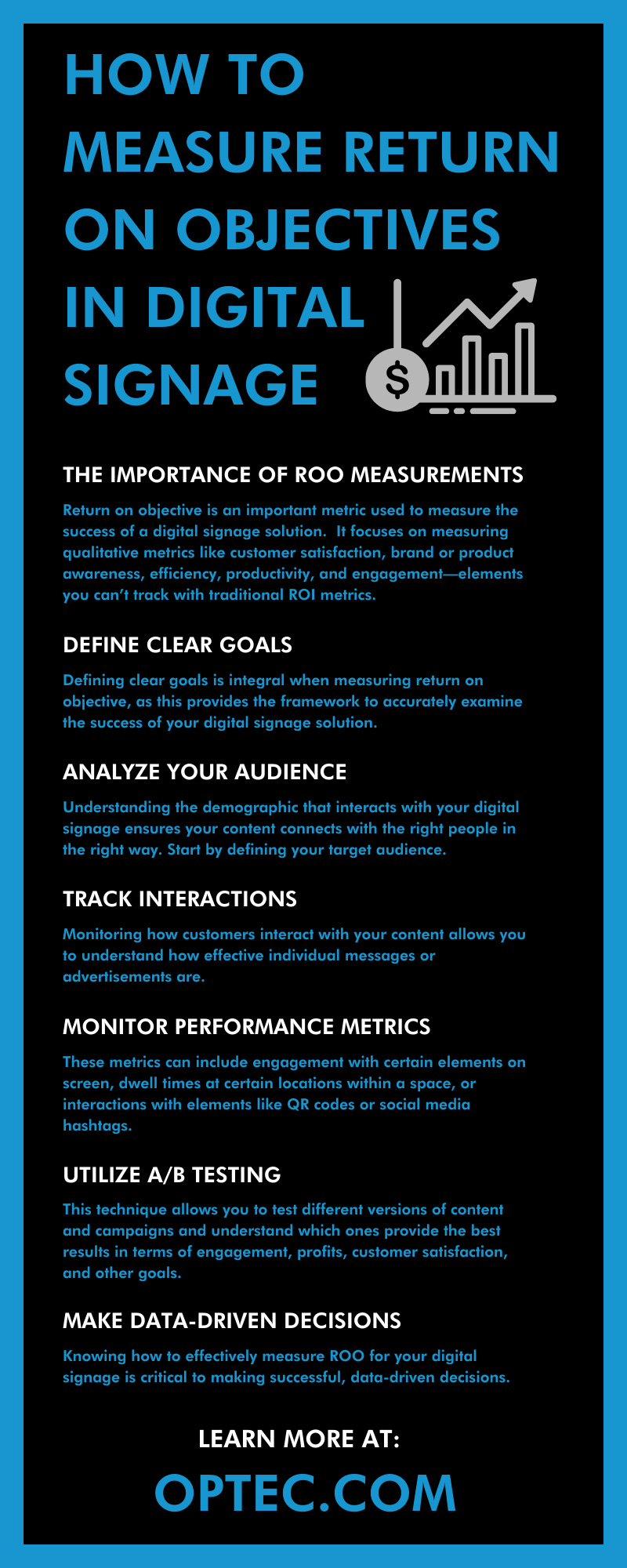How To Measure Return on Objectives in Digital Signage

Digital signage is a powerful tool for businesses and organizations to increase visibility, engage customers, and promote products or services. But how do you know if your digital signage strategy is actually effective? The answer lies in measuring the return on objectives (ROO) of your digital signage initiatives.
In this blog post, we will discuss what ROO is and how it can help you measure success with digital signage. This, in turn, will help your business make informed decisions about your overall marketing strategy. With the right data points, businesses can make the most of their digital signage investments and maximize ROO for better engagement, brand recognition, and profits. Read on to discover the best strategies and tips for how to measure return on objectives in digital signage.
The Importance of ROO Measurements
Return on objective is an important metric used to measure the success of a digital signage solution. While return on investment (ROI) focuses solely on the financial returns of a particular venture, ROO takes a more holistic view of the effects of your investment. It focuses on measuring qualitative metrics like customer satisfaction, brand or product awareness, efficiency, productivity, and engagement—elements you can’t track with traditional ROI metrics.
By understanding what ROO is and how you can use it to measure your success better, you can make sure you optimize your digital signage investments to their full potential. These qualitative measurements provide crucial information about how your customers engage with your signage solutions, giving you invaluable feedback for improving your strategies. Knowing how to define, measure, and analyze ROO is critical in today’s competitive environment, as it gives you concrete results that can have real implications for your company’s success.
Define Clear Goals
Defining clear goals is integral when measuring return on objective, as this provides the framework to accurately examine the success of your digital signage solution. To track ROO, you must establish specific, measurable objectives that align with your short-term and long-term success needs. This will enable you to track your return over time and optimize your signage solutions accordingly.
One example of a measurable objective you can work toward with your digital signage is customer satisfaction. Tools like customer surveys, review sites, and other kinds of feedback gathering help you monitor how customer satisfaction levels change along with your digital displays.
By creating specific goals—such as receiving a specific average star rating or hitting a certain percentage of positive reviews—you can clearly monitor how your signage improves customer feedback. This also allows you to keep track of areas where your signage falls short and develop targeted solutions to improve your content and overcome those roadblocks.
Analyze Your Audience
Audience analysis is another critical part of ROO. Understanding the demographic that interacts with your digital signage ensures your content connects with the right people in the right way. Start by defining your target audience. What demographic are you trying to attract? What are their interests and values? The more you know about your target audience, the easier it is to create engaging content that matches consumer preferences.
It’s also vital to know how, when, and why your target demographic engages with content. Track data such as when and how often your audience views your content. For example, do you have a lot of morning commuters passing your outdoor LED digital signage? If so, you can make content more relevant with good morning messages, sunny imagery, or even forecasts for the day.
Using audience analysis gives you the crucial insights you need to make strategic content decisions that attract and engage viewers.
Track Interactions
Monitoring how customers interact with your content allows you to understand how effective individual messages or advertisements are. This, in turn, helps you to better tailor your content to create more effective and engaging displays. Additionally, you can use analytics to measure how customer interactions with your content affect objectives like purchase decisions, return visits, and overall engagement rates. By analyzing this data and staying up to date on customer interests and trends, businesses can further refine their marketing campaigns for a more successful return on objective.
Monitor Performance Metrics
It is important to consider a variety of performance metrics when assessing your ROO. These metrics can include engagement with certain elements on screen, dwell times at certain locations within a space, or interactions with elements like QR codes or social media hashtags. These types of data points help you better understand user engagement levels over time, across different areas, or among different demographics in an environment.
By analyzing performance metrics and user engagement levels, you can understand what kinds of messages and media impact your viewers. Doing so allows you to set actionable goals to optimize your return on objective with more effective, engaging, and successful content solutions.
Utilize A/B Testing
A/B testing is a powerful way to measure return on objective for digital signage solutions. This technique allows you to test different versions of content and campaigns and understand which ones provide the best results in terms of engagement, profits, customer satisfaction, and other goals. By leveraging A/B testing, users can create optimized content experiences that are more likely to maximize return on objectives for their digital signage solutions.
Make Data-Driven Decisions
Knowing how to effectively measure ROO for your digital signage is critical to making successful, data-driven decisions. When you know how to assess ROO, you can use data analysis to adjust displays and content strategies as needed. Leveraging analytic data gives an extra layer of insight into what works well and what changes will help you meet your goals more efficiently and effectively. By using return on objective to direct decisions about changes in your digital signage strategy, you can ensure that your solutions are as successful as possible.
When it’s time to rethink your digital signage solutions, make sure you choose displays that help you achieve your goals and find greater success as a business. Optec Displays is a leading expert in outdoor LED digital signage and other digital display solutions. Contact our team today to start working on a signage solution that will help your company reach greater heights than ever before.


